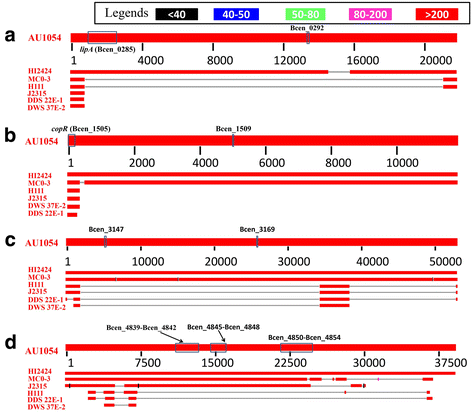Identification and analysis of genomic islands in Burkholderia cenocepacia AU 1054 with emphasis on pathogenicity islands
- PMID: 28347342
- PMCID: PMC5369199
- DOI: 10.1186/s12866-017-0986-6
Identification and analysis of genomic islands in Burkholderia cenocepacia AU 1054 with emphasis on pathogenicity islands
Abstract
Background: Genomic islands (GIs) are genomic regions that reveal evidence of horizontal DNA transfer. They can code for many functions and may augment a bacterium's adaptation to its host or environment. GIs have been identified in strain J2315 of Burkholderia cenocepacia, whereas in strain AU 1054 there has been no published works on such regions according to our text mining and keyword search in Medline.
Results: In this study, we identified 21 GIs in AU 1054 by combining two computational tools. Feature analyses suggested that the predictions are highly reliable and hence illustrated the advantage of joint predictions by two independent methods. Based on putative virulence factors, four GIs were further identified as pathogenicity islands (PAIs). Through experiments of gene deletion mutants in live bacteria, two putative PAIs were confirmed, and the virulence factors involved were identified as lipA and copR. The importance of the genes lipA (from PAI 1) and copR (from PAI 2) for bacterial invasion and replication indicates that they are required for the invasive properties of B. cenocepacia and may function as virulence determinants for bacterial pathogenesis and host infection.
Conclusions: This approach of in silico prediction of GIs and subsequent identification of potential virulence factors in the putative island regions with final validation using wet experiments could be used as an effective strategy to rapidly discover novel virulence factors in other bacterial species and strains.
Keywords: B. cenocepacia AU1054; Genomic Island; Pathogenicity Island; Virulence factor.
Figures



Similar articles
-
Genomic analysis of Burkholderia cenocepacia isolated from a liver abscess in a patient with cystic fibrosis.APMIS. 2021 Nov;129(11):631-640. doi: 10.1111/apm.13177. Epub 2021 Oct 19. APMIS. 2021. PMID: 34561922
-
Insights into the genome diversity and virulence of two clinical isolates of Burkholderia cenocepacia.J Med Microbiol. 2018 Aug;67(8):1157-1167. doi: 10.1099/jmm.0.000759. Epub 2018 Jun 13. J Med Microbiol. 2018. PMID: 29897328
-
A computational approach for identifying pathogenicity islands in prokaryotic genomes.BMC Bioinformatics. 2005 Jul 21;6:184. doi: 10.1186/1471-2105-6-184. BMC Bioinformatics. 2005. PMID: 16033657 Free PMC article.
-
Identification and characterization of pathogenicity and other genomic islands using base composition analyses.Future Microbiol. 2006 Oct;1(3):309-16. doi: 10.2217/17460913.1.3.309. Future Microbiol. 2006. PMID: 17661643 Review.
-
Burkholderia cenocepacia in cystic fibrosis: epidemiology and molecular mechanisms of virulence.Clin Microbiol Infect. 2010 Jul;16(7):821-30. doi: 10.1111/j.1469-0691.2010.03237.x. Clin Microbiol Infect. 2010. PMID: 20880411 Review.
Cited by
-
Impact of template denaturation prior to whole genome amplification on gene detection in high GC-content species, Burkholderia mallei and B. pseudomallei.BMC Res Notes. 2024 Mar 12;17(1):70. doi: 10.1186/s13104-024-06717-8. BMC Res Notes. 2024. PMID: 38475810 Free PMC article.
-
Comparative Evolutionary Patterns of Burkholderia cenocepacia and B. multivorans During Chronic Co-infection of a Cystic Fibrosis Patient Lung.Front Microbiol. 2020 Sep 25;11:574626. doi: 10.3389/fmicb.2020.574626. eCollection 2020. Front Microbiol. 2020. PMID: 33101250 Free PMC article.
-
Genome-based classification of Burkholderia cepacia complex provides new insight into its taxonomic status.Biol Direct. 2020 Mar 4;15(1):6. doi: 10.1186/s13062-020-0258-5. Biol Direct. 2020. PMID: 32131884 Free PMC article.
-
Identification by Reverse Vaccinology of Three Virulence Factors in Burkholderia cenocepacia That May Represent Ideal Vaccine Antigens.Vaccines (Basel). 2023 May 30;11(6):1039. doi: 10.3390/vaccines11061039. Vaccines (Basel). 2023. PMID: 37376428 Free PMC article.
-
Genomic features, antimicrobial susceptibility, and epidemiological insights into Burkholderia cenocepacia clonal complex 31 isolates from bloodstream infections in India.Front Cell Infect Microbiol. 2023 Apr 19;13:1151594. doi: 10.3389/fcimb.2023.1151594. eCollection 2023. Front Cell Infect Microbiol. 2023. PMID: 37153161 Free PMC article.
References
-
- Regan KH, Bhatt J. Eradication therapy for Burkholderia cepacia complex in people with cystic fibrosis. Cochrane Database Syst Rev. 2014;10:CD009876. - PubMed
Publication types
MeSH terms
Substances
LinkOut - more resources
Full Text Sources
Other Literature Sources

